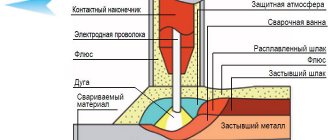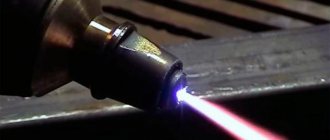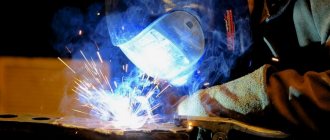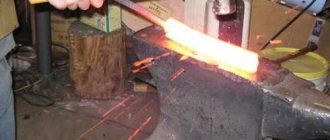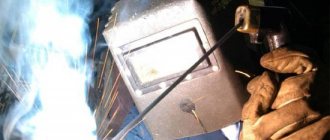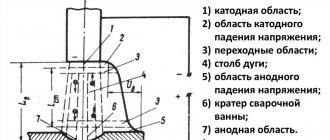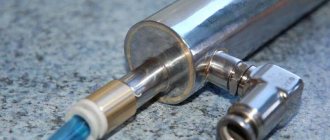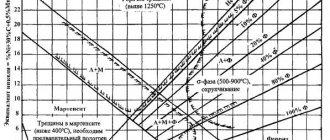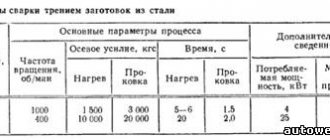In a broad sense, welding is the joining of parts by partial melting, during which the material is softened and mixed, forming a homogeneous mass. Simultaneously with cooling, the material hardens - in fact, sheets, pipes or any other parts are fused together. A weld is formed.
A good seam has strength comparable to the strength of the connected parts. It's not just metals that can be welded. Many types of household plastics lend themselves well to welding. But the technology of welding plastic differs significantly from the technology of welding metals.
Influencing factors
Welding plastic is a simple process even at home, but for the work to be successful, a number of conditions must be met. Only plastics from the group of thermoplastics can be welded.
Thermoplastics are a type of plastic that fully retains its properties when heated, melted and subsequently hardened. In this they differ from thermosets, which after final processing (casting or stamping of the product) cannot be heated without destruction.
Simply put, at high temperatures, thermoplastics melt, but then harden, and thermosets char and burn. The scope of application of thermosets is much narrower. In everyday life, different types of thermoplastics are much more common.
The following types of thermoplastic plastics can be welded:
- polyethylene (high and low density);
- polypropylene;
- polyvinyl chloride;
- polystyrene;
- polyvinyl acetate;
- polyethylene terephthalad;
- polycarbonate;
- nylon.
Only homogeneous plastics can be connected to each other by welding - nylon to nylon, polystyrene to polystyrene, and so on.
Two approaches
Welding of plastics can be done in various ways. But there are two main approaches - temperature and cold. The first is based on exposing the plastic to a relatively high temperature (in the range of 200-300 °C for different types of plastics).
Thermal welding of plastic can be carried out:
- flow of hot gas (air, nitrogen, argon);
- hot contact tool (soldering iron, special machine for welding plastic);
- molten additive;
- friction;
- ultrasonic waves;
- spot heating with laser, infrared or other light radiation;
- high frequency electric current.
The principle of cold welding is different. It is also divided into two fundamentally different subspecies. The first is welding the plastic by partial melting using chemical solvents.
Under the influence of certain chemicals, the edges being joined soften, join under pressure, and cool under pressure. Due to the complexity, as well as the fact that the most popular polymers polyethylene and polypropylene are not amenable to this method, it is rarely used in everyday life.
The second subtype is the use of a two-component polymer composition, according to the same principle as cold welding of metal. It is not real welding, but it can provide a fairly strong connection, close to the strength of the plastic surfaces being joined.
Most common methods
Before talking about the most accessible ways for the user to weld plastic, you need to decide on the scope of application of this method of fastening at home.
As a rule, this is either a hermetically sealed connection of plastic water pipes, including in areas where water flows under pressure, or the connection of sheet plastic for various purposes - the manufacture of some products, the repair of plastic cans, tanks, bumpers.
Please note that welding is often used by divers to repair wetsuits with appropriate coatings.
Next, emphasis will be placed on methods and tools for manual welding of plastic, since machine welding methods involve complex and expensive equipment. These include laser, infrared, ultrasonic plastic welding, friction welding and some other methods. At the same time, connection via direct contact with a thermal tool, using hot gas or an extruder, is technologically quite accessible to a home craftsman or mobile repairman.
Applied methods of welding thermoplastics
The thermoplastic welding process can be performed: with a heat gun or hair dryer, using an extruder or contact welding. The peculiarity of this process is that the material is heated to a viscous-fluid state, using low pressure.
Before welding (by any method), it is necessary to prepare the plastic, namely, clean it from dirt or damage approximately 20 minutes before starting work.
The filler rod is selected according to the chemical composition suitable for the base plastic being welded. It is important to remember that filler rods for plastic become brittle at temperatures below +15 °C. The rods can have different cut shapes: round, triangular.
Approximate cost of welding rods on Yandex.market
Using a hair dryer or heat gun
A manual hot air supply unit is popular due to its ease of use in different conditions, including domestic ones. This group includes construction hair dryers, so-called heat guns with the ability to heat air to high temperatures. This welding technology is used for materials with a thickness from 1 mm to 10 mm. If a welding rod is additionally used, it is also heated with heated air. Welding guns are sometimes used in conjunction with a soldering iron.
There are two methods of welding using hot air supply devices:
- Welding using filler material (butt).
- Overlap welding of thermoplastics, without welding rods.
The welding gun has special attachments:
- fixing , for clamping welding products before welding;
- slotted , for roofing materials;
- forming , for welding large plastics.
Thanks to the attachments, the hair dryer can be used for different types of structures compared to a heat gun. A hot-melt gun is often used for overlap welding of thermoplastic plastics, and with the help of a hair dryer, materials are joined end-to-end with the addition of a filler rod to the area of the weld.
Approximate cost of construction hair dryers on Yandex.market
Features of working with a hair dryer or heat gun:
- The diameter of the filler material should not be more than 4 mm in order to heat up in a short period of time.
- The welding process must be carried out quickly enough to avoid decomposition of the material.
- Strict temperature control, according to the type of thermoplastic . The quality of work is affected by both overheating and underheating.
Equipment:
- heat gun or hair dryer;
- filler material;
- respirator and gloves.
Welding plastic using an extruder
Using an extruder for welding plastic is considered the most convenient and economical. The extruder feeds the already molten (softened) mass into the weld, which is pressed down by the guide nozzle. This device is used to connect products with large thickness.
Advantages of working with an extruder:
- less energy consumption;
- improved heat transfer method;
- no need to use clamping devices;
- full control over the quality of the weld seam.
Welding with an extruder begins with preparing the product (cleaning), then tightly joining the welding areas (you can do this manually). The welding process can be carried out at a moderately fast pace; be sure to set the temperature regime for the thermoplastic type of plastic. After completion of work, the part must remain stationary until it cools completely.
Equipment:
- extruder;
- filler material for plastics;
- protective elements (respirator, gloves).
Approximate cost of an extruder on Yandex.market
Contact heating method
Technologically, this is the simplest method of welding plastic. It doesn't even require electrodes. But the design of the apparatus used is different for welding sheet materials or, for example, for connecting pipes.
The simplest apparatus used for welding small parts is a regular 220 V electric soldering iron. To increase the heating area, and also to avoid damaging the tip, a special nozzle can be used.
It can weld the most common plastics - polyethylene and polypropylene. Most household plastic parts are made from them.
The principle of this method is simple. The edges of the parts are heated (for polyethylene and polypropylene the temperature should be 200-260 °C), overlapped or butt-to-butt and pressed tightly in a clamp or vice.
Cooling must occur under pressure, otherwise it will not be possible to achieve a high-quality seam. Before starting work, it is recommended to clean and rinse the edges .
A special welding machine is used for welding sheet plastic in large volumes. Connecting pipes by heating also requires a special tool. Welding machines for pipes are divided into 2 types - for butt welding and for socket welding.
The second method is intended for welding pipes of different diameters that fit tightly into one another. Such devices provide the necessary pressure.
Hot gas
Gas welding of plastic means that a directed flow of hot air or industrial gas - argon, nitrogen and others - is used to soften the material. In domestic conditions, air is usually used, and the tool for supplying it is a hair dryer.
The temperature of the supplied gas should be approximately 80-100 ° higher than the temperature of viscosity, that is, softening of the welded metal to the desired condition. Under these conditions, it is also necessary to ensure pressure on the plastic edges being joined. To do this, you can use a pressure roller, which is moved along the seam following the hair dryer (the help of another person is required), or special fixing attachments for the hair dryer.
This attachment allows you to compress the surfaces during welding. Specially for processing large-format sheets - banners, awnings, blood elements - crevice and forming attachments have been developed for a standard industrial hair dryer (heat gun).
In industry, a special gas composition is more often used to ensure the absence of oxides in the weld, which weaken its structure. In everyday life this is not critical, since the load on plastic parts is usually insignificant.
Gas heating imposes a limitation on the thickness of the material being welded - no more than 2 mm. Optimal - 1.5 mm .
Gas welding of plastic can be done either without the use of filler material or with an additive. The role of the additive is played by the so-called electrodes - rods made of plastic of various brands (selected based on the brand of plastic), with a diameter of 2 to 6 mm.
Calling them electrodes is not entirely correct. No current flows through them during gas welding (almost all plastics are dielectrics). But the name stuck simply by analogy with metal welding.
The use of an additive can increase the strength of the seam and deepen the weld. This method is suitable for fastening thicker parts. It is possible to either manually feed the additive with rolling or use special equipment - an extruder, an extrusion gun.
Welding of plastics. ABC of technology
Extrusion welding (melt welding). further ES
This type of certificate applies to manual semi-automatic welding of plastics. ES allows welding both straight seams and seams of complex geometry (for example, welding hatch holes in cylindrical containers). In this way, you can weld parts with a thickness of 2 mm or more (fixed on a rigid base, otherwise the edges will “spread” and the plane of the part will “pull”. ... It will still “pull”). The positive effect of ES manifests itself when welding parts from 5 mm. Advantages: high quality (design strength 80% at high speed, allows you to weld thick-walled parts in one pass. The speed depends on the thickness of the parts (seam cross-section), filler wire cross-section and welding extruder productivity (measured in kg/h).
ES principle: into the cut, fixed edges, pre-heated with hot air, a melt is continuously fed through the welding shoe of the extruder, filling the cut and the gap between the parts. The weld leg is formed by applying pressure through the extruder to the welding shoe. The shape of the weld leg is determined by the profile of the welding shoe. For each type and size of seam, it is necessary to have a separate replaceable welding shoe (for example, corner, butt, overlap, transition, for welding conical bottoms, and all this multiplied by the variety of material thicknesses you plan to work with). Usually, when purchasing an extruder, the kit includes 2-3 shoes and a workpiece. The shoes are made of fluoroplastic4 with a duralumin “heel”. You can (should) make them yourself
Types of welding extruders:
1. Plunger welding is the simplest “intermediate option” between hot air welding with an additive and pipe-extrusion welding. Relatively low-productivity. The plunger extruder does not have a plasticization chamber or a screw, and the melt is not mixed. Operating principle: an additive in the form of a wire with an almost perfectly round cross-section is fed through a feed mechanism through a tube passing through the “nozzle” (at the same time, the additive heating chamber) of the hair dryer. In this case, hot air, passing through the “nozzle” (heating chamber), heats the additive until it disintegrates and at the outlet heats the edges of the parts being welded. The melt from the tube is squeezed into the weld zone by a constantly incoming unmelted solid wire, which plays the role of a “piston” (plunger). In principle, it is available for self-production if you select the cross-section of the tube and the optimal contact area between the tube and hot air (IMHO). Factors to consider: Uncontrolled melt temperature, depending on hot air temperature, duration of stops (average additive flow), ambient temperature. environment.
Advantages: small size, weight.
2. Screw Tru-welding extruder is a high-performance manual semi-automatic welding machine. It has a separate air duct from the hair dryer to the edges and a plasticization chamber independent of the hair dryer. An additive (wire or granules) is fed into the plasticization chamber by a feed mechanism. There it is mixed and heated to a certain temperature, and the melt, through the welding shoe, is squeezed out into the welding zone by a screw. The set temperature of the melt is maintained by the control unit by periodically turning the heating elements on and off. Available for self-production (assembly from different elements). I guarantee it.
Nuances:
The weight of my extruder is 15 kg. Its weight grows exponentially every second if you weld a vertical or ceiling seam. At the same time, the large mass of the extruder helps when welding a seam on the floor.
For ES, for example, polypropylene, a hair dryer air flow rate of 300 l/min is required. Air temperature 260-291 C.
Dropping (or otherwise “harming” the extruder) is not economically feasible.
Compared to welding with hot air (hair dryer) with an additive, the welding speed with my extruder is 6-10 times higher
There are extruders with a hair dryer powered by compressed air and with a self-pumping hair dryer. For compressed air hair dryers, especially clean air preparation is required, plus, on top of everything, an additional hose (which, for some reason, always gets tangled in the filler wire, gets tangled underfoot and tends to get crushed and broken) to the extruder.
1. Replaceable welding shoe
2. Good quality seam
3. The seam is of excellent quality, with processing (not my work)
4. Overheating of the additive in the seam (before starting to cook, you need to “blow out” the plasticization chamber)
5-6 Extruder
Modified March 22, 2014 by Termoplastic
Extruder Application
An extruder is a device for supplying filler material to the welding area. Its use greatly simplifies the welding process.
A manual plastic extruder looks like a gun combined with a heat gun. An filler rod is continuously fed through it, surrounded by a stream of hot air.
Extruders are divided into 2 types - non-contact and contact. In the first case, the nozzle is not immersed in the weld, and the pressure is provided by the pressure roller.
In the second case, the nozzle of the apparatus passes directly inside the weld, and this applies the necessary pressure. The extrusion method of welding plastic is the simplest, fastest and most reliable among all types of manual welding; it is second only to automatic and semi-automatic methods.
Thermoplastic types of plastic
Thermoplastics become plastic when heated, and when cooled they return to their shape without losing their original properties. Their heating temperature is often in the range of 140-240 °C; overheating leads to decomposition of the plastic.
Types of thermoplastic plastic:
- polyethylene (high-density polyethylene is less durable and heat-resistant compared to low-density polyethylene);
- polyvinyl chloride (good dielectric constant);
- fluoroplastic (high resistance to aggressive chemical environments);
- polypropylene (the lowest density among all types of plastics, hard and heat-resistant, melting point 175 °C);
- polystyrene (fragile, low heat resistance 80 °C);
- polymethyl methacrylate (organic glass, has anti-corrosion and dielectric properties, low mechanical strength);
- polyethylene terephthalate (melting point 260 °C, decomposition point 350 °C, insoluble in organic solvents and water);
- polycarbonate (high coefficient of thermal expansion, plastic and durable, unstable to long-term UV radiation);
- polyamides (nylon, nylon have wear resistance with high surface hardness).
Each species has its own temperature regime for melting and decomposition. Only one type of plastic is suitable for welding joints.
Properties of thermoplastics:
- Strength in different temperature ranges.
- Dielectric capacity (not for all species).
- Resistance to mechanical wear.
When welding plastic, respiratory protection is required, since during the heating process a lot of harmful substances are released from the plastic.
